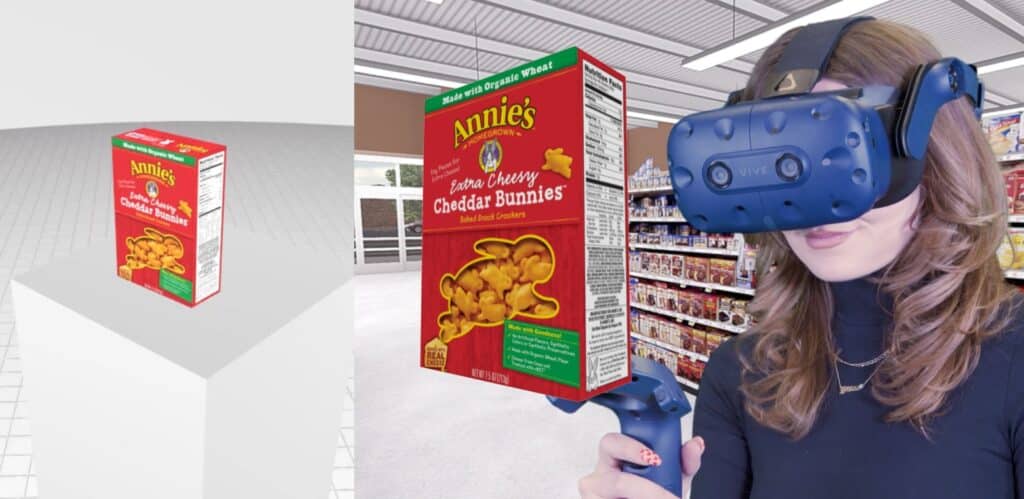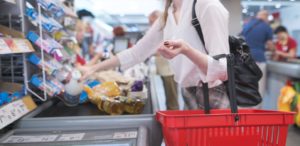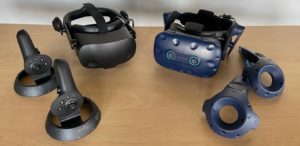How VR is Revolutionizing Packaging Design and Research

Virtual reality offers an innovative packaging design solution for the food and CPG industry.
Virtual Reality (VR) is changing packaging design and research by offering unique capabilities to innovate, iterate, and optimize. Traditionally, packaging design involved labor-intensive processes such as creating physical mock-ups and conducting extensive testing. This consumes time and materials. Designers may need to iterate multiple times before finalizing a design that meets all requirements.
However, with VR, companies can now transcend these limitations. Immersed virtual environments allow designers to visualize and interact with packaging prototypes in three dimensions. Gaining invaluable insights into aesthetics, functionality, and user experience.
Ultimately, VR empowers companies to unlock new levels of creativity, efficiency, and sustainability in packaging design, shaping the future of the industry.

Virtual Reality Packaging Design
3D packaging design utilizes digital tools and virtual environments to create and visualize packaging concepts. Designers can create virtual prototypes quickly and make adjustments in real-time without the need for physical materials. This process allows for faster iteration and collaboration among team members.
Additionally, VR technology offers immersive experiences, allowing designers to simulate how the packaging will look and function in different environments or scenarios. This level of realism can help identify potential issues early in the design process and make more informed decisions.
Overall, 3D packaging software offers advantages such as speed, cost-effectiveness, enhanced collaboration, and realistic visualization compared to traditional methods.

CPG Packaging Design using VR
Food packaging design uses substantial quantities of plastic or other materials to craft mock-ups for testing. Each physical packaging iteration must undergo multiple drop tests and shopper surveys, a process that can be time-consuming. Especially when considering the need to test various package iterations. This traditional approach to testing often leads to prolonged development cycles, hindering the pace of innovation and market responsiveness.
Consumer packaged goods (CPG) giants like Mars and Unilever are adopting innovative methods for prototyping packaging. By embracing 3D models and virtual prototype testing, they can save time, money and materials developing innovative food packaging. Helping them optimize process efficiency and meeting sustainability goals. Thoroughly evaluating design elements and reducing plastic packaging waste not only optimizes the supply chain but also enhances competitiveness in the market.

VR Packaging Research
Today, we can research packaging quickly and affordably using 3D models in virtual reality. VR research influences the packaging industry by simplifying package testing for product innovation teams. It enables companies to better explore their packaging options through rapid establishment and execution of tests with unprecedented efficiency.
Through using innovative packaging solutions in VR, researchers unlock unlimited package testing and refinement. They can simply upload image artwork onto 3D model templates and become ready to administer a shopper study. Leveraging the packaging performance data from these studies, teams can optimize designs, ensuring products meet and exceed market expectations.
Allowing for ease of exploring different types of packaging or graphic design. Giving companies the ability to better understand their target audience. By discovering how certain box designs may influence purchase decisions or affect the interpretation of their brand identity.
Moreover, VR enables rapid iteration and testing of multiple design variations, significantly reducing development cycles and costs. Through immersive simulations, stakeholders can simulate real-world scenarios, such as shelf placement and consumer interaction. This allows for informed decision-making and refinement of packaging solutions.
Subscribe to our newsletter
Get our blogs and the latest retail news delivered to your inbox monthly.
Recent Posts
6 Things in Future Gas Stations and Convenience Stores
Consumers influenced by the pandemic and an increasingly digital world are accelerating convenience store innovation. The increasing adoption of electric vehicles and pending self-driving cars/fleets are reshaping the future of convenience stores. These new technologies are paired with increasingly digitally reliant consumers, which require convenience stores to rethink their shopping experiences and the role they…
5 Front End Challenges & How Retail is Reinventing the Future of Brick and Mortar
New technologies and consumer behaviors have made retailers realize they need to quickly reinvent the in-store experience at checkout. Consumer behaviors rapidly changed during the pandemic and impacted the retail front end as it is considered a high contact area. Fear to touch checkout merchandise and machines has led to poor front end performance that…
HTC Vive Pro Eye vs. HP Reverb G2 Omnicept: Which is Best for Market Research?
VR has found its way into accelerating the retail innovation process through better market research. Selecting the right virtual reality hardware is part of successfully adopting new technology. Virtual reality is no longer just a form of entertainment. It is now being used in business for better training, planning, testing, and collaboration. The retail industry…




[…] the most critical elements of your packaging are noticed by utilizing eye-tracking capabilities in virtual reality packaging design research. VR consumer market research in both in-person and online studies enables you to quickly identify […]
[…] helping them identify the right flavors to match evolving consumer preferences. By using simulated 3D models for packaging design of various flavor profiles and formats, manufacturers can quickly gauge consumer reactions and […]